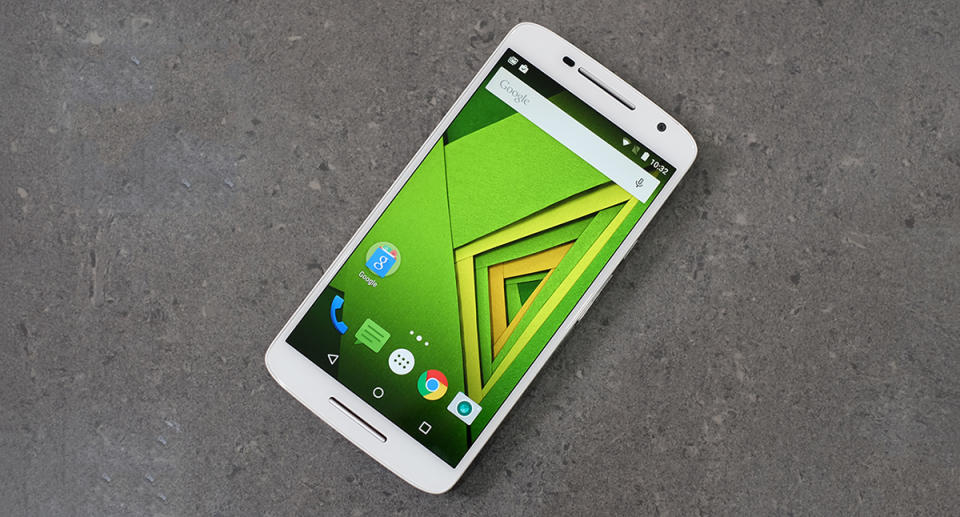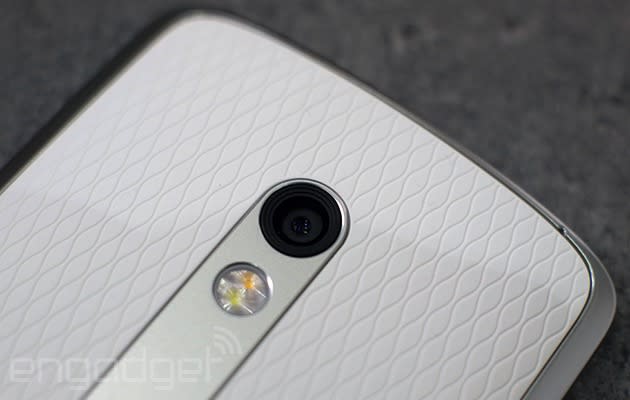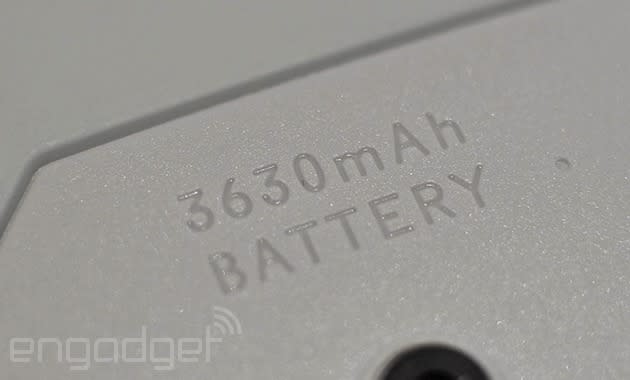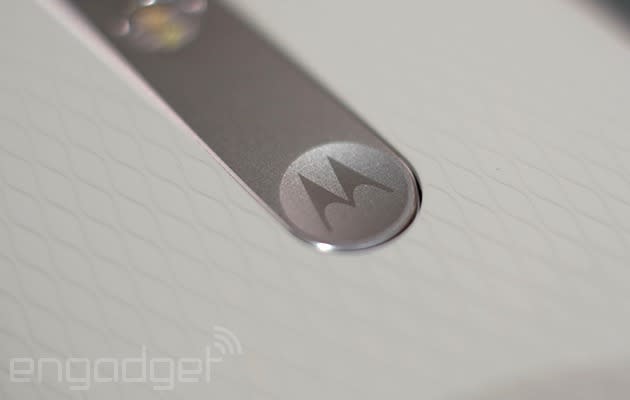Moto X Play review: An unexciting phone with a huge battery

The Moto X Play occupies a strange space in the company's 2015 lineup. It's an affordable, mid-range handset that does a decent job of keeping pace with the flagships. But at £249 ($382 including the UK's 20 percent sales tax), it's not that much more affordable than the company's top-tier X Style, and it's a lot pricier than our favorite budget smartphone, the Moto G. That's not to say there aren't benefits to splashing out on the X Play. You'll get a larger, higher-res display than on the G, an all-new 21-megapixel camera, a capacious 3,630mAh battery and a whole lot more. If you've got your heart set on a Moto, could these additions be worth the extra cash? It really depends on what you want from a smartphone.
Hardware

The OnePlus 2 has already proven that you can get a lot of phone for a few hundred dollars. In the case of the X Play, however, you're not getting cutting-edge specs. Inside, there's an octa-core Snapdragon 615 processor paired with 2GB of RAM, and a choice of 16GB or 32GB of built-in storage, expandable by microSD. Of course, there are plus sides to these mid-range specs, especially when you consider the battery size. But more on that later.
Design wise, Motorola clearly knows it was onto a good thing with the original Moto X, as it's continued to play with that striking profile ever since. Unfortunately, the X Play is actually the least attractive iteration of this theme. Up front, everything's pretty much as you'd expect: an expansive, 5.5-inch 1080p display with fairly thin bezels. But there's a lack of attention to detail here.
This is the least attractive iteration on the Moto X theme.
Take the cutouts for the speakers that are above and below the screen, respectively, as an example. Vertically, they're poorly aligned, with the lower slot centered, but the upper one placed high above the display. It makes the phone look oddly imbalanced, especially as they're the same size and neatly horizontally aligned. This is exacerbated by the haphazardly positioned front-facing camera and light sensor, which again just seem to have been placed without a care in the world. While I'm aware that most people won't know why it looks odd, a straw poll of friends and family showed that most thought "something was off."
The X Play is wrapped in a cheap-but-sturdy metallic plastic that curves around from its sides to the rounded back casing, accented by Moto's familiar camera unit, complete with dimpled "M" logo. On the right side of the phone are the only two buttons you're getting: a power and volume rocker -- as on all of Motorola's phones, you won't find a dedicated camera key. Unlike the cheaper Moto G, there's no waterproofing here. Instead, the X Play is "water resistant," which means it will survive a splash, but not a fall into your toilet.
The back of the phone is a pleasant soft-touch plastic with a grippy pattern. I strongly dislike the ergonomics of large phones, but it has to be said that this feels like it'd be very hard to drop. Although you can take off the backing, the battery is non-removable, and the combined SIM/microSD slot is actually atop the device next to the headphone port. So, rather than being functional, the swappable backs are for aesthetic reasons. Useful if you get tired of whatever garish color scheme you've invented for yourself in the company's Moto Maker customization tool, I suppose.
I know I'm harping on about the design a little, but the cheap plastic wrapping around the sides really doesn't scream premium, and looks at odds with the device's curved back. As on the front of the device, Motorola doesn't appear to have put much thought into the finer details, the lines and how they flow into one another. It's weird because Motorola did a good job with the Moto G of creating a premium-feeling device on the cheap. Sure, the more-expensive X Style has its own interesting design flourishes, but perhaps because of budget constraints, the X Style pulls it off, and the X Play does not.
Display and sound

With smartphone displays fast-approaching 4K resolutions, the X Play's 5.5-inch 1080p screen might not seem anything special. It's more than up to the task, though.
Motorola has switched to IPS display tech this year, which would usually mean that colors don't have that AMOLED punch that last year's X does, but the company has implemented a software trick to combat that. By default, the display is set to "vivid," which does a decent job of boosting saturation, if that's your thing. I quickly switched to "natural," which makes things look far less gaudy.
Unsurprisingly for an IPS display, viewing angles are top-notch, and the screen is also super bright and readable even in direct sunlight. For some reason adaptive brightness was switched off out of the box, and I had to dig through the settings to turn it on. All told there's nothing spectacular about the X Play's display, but there's also very little to complain about.
The same can't be said for audio quality. Despite their appearance, those misaligned slots don't actually house matching dual speakers. Up top there's a standard speaker for calls, while down below is a loudspeaker. It's by no means the worst I've heard, but it's a little on the tinny side, especially if you're coming from one of HTC's or Samsung's phones. Not having stereo sound feels like an unnecessary corner to cut and something that would've set apart the X Play from the cheaper G. Think about it: If you're watching movies or playing games, do you want all the sounds coming from one side of the display?
Software

As we've come to expect from Motorola, the X Play offers an uncluttered take on Android 5.1.1, with little in the way of additions. The few changes it brings are fairly useful.
Moto Display is probably my favorite. Whenever a notification comes in, a small icon appears on an otherwise black display. Holding your finger on that icon gives you more information, and you can swipe up from there to jump straight in to the relevant application. That's cool, but what's cooler is you can bring up this functionality just by moving the phone slightly. I've gotten quite used to giving the phone a little nudge as it sits on my desk to see what's waiting for me inside. The downside to that is there's no notification LED. For me, the additional context Moto Display offers is worth the trade-off, but it might not be for you.
Next up is Moto Assist, which automatically adjusts settings in exchange for a little information. Tell it when you sleep, for example, or give it access to your calendar, and it'll turn off notifications at the appropriate times. Also included is Moto Voice, which listens out for a key phrase at all times (mine was, "What's up Moto X?") to activate a little voice assistant that'll let you place calls or ask various questions. I spend my life trying to speak as little as possible, so it's really not the ideal feature for me, but if you enjoy talking to inanimate objects, it's accurate enough.
Motorola's additions are moderately useful, but easy to ignore.
Way down at the bottom of the usefulness list is Motorola's "Actions" gesture. It'll let you do things like jump straight into the camera app by contorting your wrists twice in quick succession. Quite why you'd do that when swiping left on the lock screen or clicking on an icon achieves the same thing, I'm not sure.
I'm fairly cynical about new things, and there's every chance you'll find Motorola's extras useful, especially if you've grown accustomed to waving your phone around to do things with a previous-gen Moto X. One great thing about the additions, though, is how easy they are to ignore. Every bell and whistle can be deactivated in the "Moto" app, after which you're just left with, well, Android. On a more positive note, Motorola has a great track record when it comes to updating its phones, so if you're anxiously waiting for Android M, this is likely to be one of the first non-Nexus devices to make the jump.
Camera

If there's one thing that Motorola has struggled with in its renaissance, it's been cameras: From the original Moto X all the way up to the Nexus 6, owners have had to make do with subpar image quality. This time around, the company has fitted the X Play with a 21-megapixel shooter, and things are much improved.
The software experience is similar to any stock Android phone, which is to say you just tap on the screen to take a photo. That means it's super quick to boot up, even from the lock screen, and takes photos in the blink of an eye. The spartan layout is great for beginners, and there's an HDR setting and a focus and exposure tool for those looking to get a little more creative with their shots.
Provided you've got a well-lit subject, you're going to get great photos. Colors are accurate without being dull or gaudy; exposure is spot-on; and the software does a good job at white balancing. I'm the sort of person who shoots manual on regular cameras, so I thought I'd miss the advanced settings found on other manufacturers' phones, but it really wasn't an issue.
Passable, but nowhere near the best.
Although it has the same-sized sensor as the Moto X Style, there's a party-trick that the X Play is missing: 4K video. The two phones have different image-processing chips inside, which means that the X Play tops out at 1080p. Because of that chip, the phone also seems a little slower to focus than the X Style. In practice, I didn't find the X Play's focusing either slow or inaccurate, but from testing them side by side at Motorola's launch event I can say the X Style is a little quicker at everything.
One area that pretty much no smartphone excels in is low-light photography, and sadly that's the case again here. It's still a marked improvement over previous Motos, but that's not saying a lot. Unless you have a super-steady hand and a still subject, you're not going to be winning any night photography prizes with the X Play. In fact, it's worse in low light than all of the competition's mid-to-high-end phones. The problem seems to be a combination of poor ISO performance and long, long shutter speeds. That means that not only are your photos going to be full of noise, but also anything that's not still will be blurry.
Performance and battery life

Qualcomm's octa-core (four cores at 1.7Ghz, four at 1GHz) Snapdragon 615 processor might not be the fastest chip on the block, and plenty of phones offer more than 2GB of RAM, but truth be told, the Moto X Play never struggled to keep pace with my daily routine. We've reached a point where less expensive phones don't slow down or stutter in regular use. Sure, the Galaxy S6 or HTC One M9 will load up your apps a little faster and play graphically intensive games at a smoother frame rate, but that's really the difference we're down to now. It's great.
My unit came with 16GB of storage, of which 10.9GB was addressable. (There's also a 32GB model available.) Unlike certain other Android manufacturers, Motorola is still giving users the option to expand that storage. The company saved space by having just a single tray house the SIM and microSD, so you won't be able to swap cards without losing cell signal, but it's still a useful addition.
In the US, the X Play looks set to be called the Droid Maxx 2. If you know your phones, you'll know that nomenclature implies this phone is built to last all day. It's got a colossal 3,630mAh battery, which, when paired with those middling specs, meant the X Play reached 14 hours and 50 minutes in our video playback test. Motorola says in the real world the X Play gives you "up to 48 hours" of "mixed use," and it did just that. In fact, you might get even longer.
Twice now the X Play has seen me through two full days' use with more than 20 percent left in the tank. A "full day's use," to me, means syncing emails; streaming a few songs on Spotify; watching some YouTube videos; and incessantly checking Engadget, Twitter and the various messaging apps I use.
I'm neither the heaviest nor lightest smartphone user, then, but I did try and put the X Play through its paces. One day I synced all three of my email accounts, streamed music over LTE for over four hours, spent three hours using the hotspot function for my MacBook, played games for two hours, watched Netflix over WiFi for an hour and placed a 30-minute Skype call. That's all in addition to my regular routine. I finished the day, 16 hours later, with 31 percent battery left. I test a lot of phones, and I have to tip my hat to the X Play's endurance.
The competition
It may seem a little overpriced and under-specced compared to cheap Chinese phones like the OnePlus 2 and ZTE Axon, but being able to use the X Play all day without worrying about it dying is kinda priceless. That said, if, like me, you're not a super-heavy user, the OnePlus 2 will easily see you through the day without a charger. Sony's also done a great job with battery life in recent years, and its mid-range handsets are worth a look.
The real competition lies within Motorola's own ranks, though. The Moto G is such a good phone, and in my opinion a more attractive one to boot. It should last you roughly a day's use -- more if you're frugal -- and you'll save a ton of money (it's over $100 cheaper in the UK). The main compromise is the camera, which struggles to keep pace with the X Play's.
And then there's the Moto X Style. It's got a super-fast processor, more RAM, a truly gorgeous 2K display and the same camera, but with phase-detection autofocus. It costs £100 more than the X Play in the UK, or $399 unlocked in the US, and you're getting a lot of extra phone for that. Of course, we've yet to put it through its paces for battery life, but chances are you won't be getting two full days' use out of it.
Wrap-up

Once you take the epic battery life into consideration, the X Play starts to make a little more sense. You get a lot of the benefits of Motorola's flagship; you save a little money; and you never need to carry your charger with you again. Even so, I can't help but feel that most people would be happy with the budget Moto G. And those looking for something better than that will probably gravitate toward the Moto X Style or any of the latest wave of "cheap" flagships. But although the X Play is still not the most exciting phone, it's a very capable one, and I can't knock Motorola for giving Android users more options.
Update: This review has been updated to clarify the difference between the Moto X Play and X Style's image processors. The update has not affected the review score or our opinion of the phone.





























